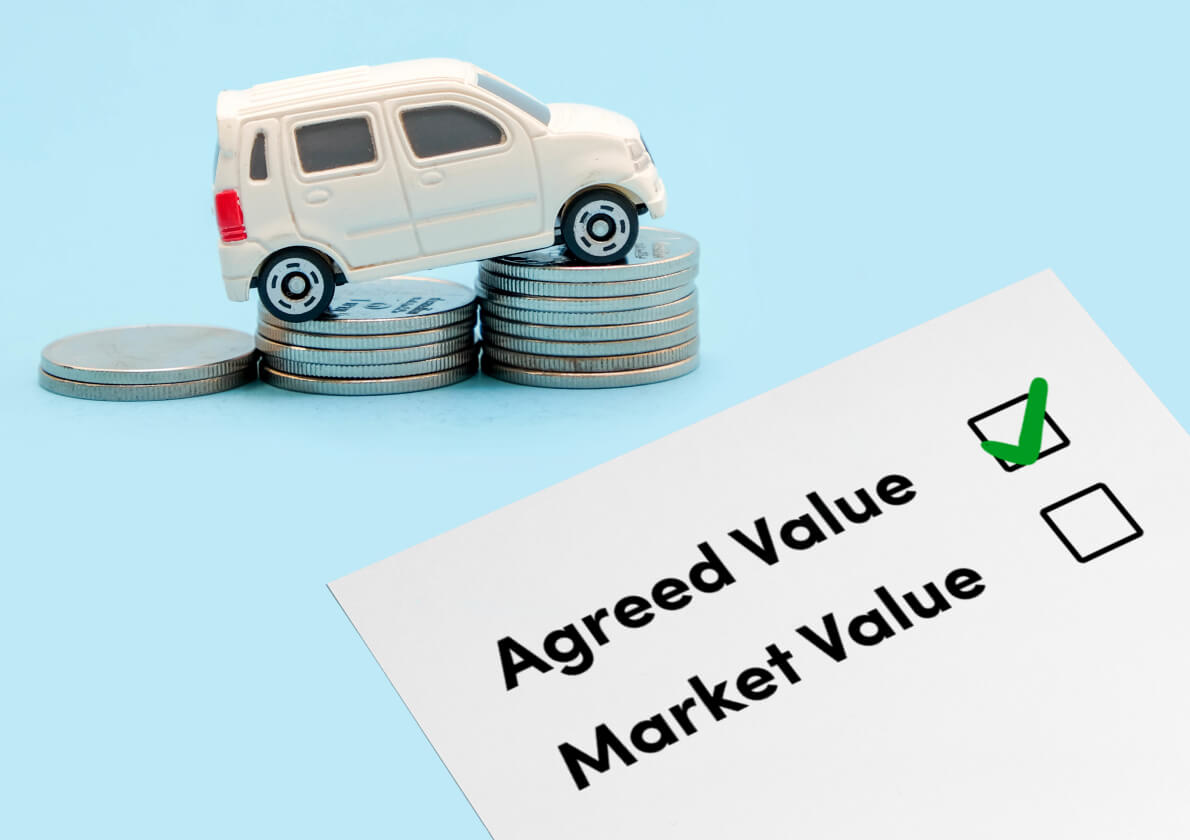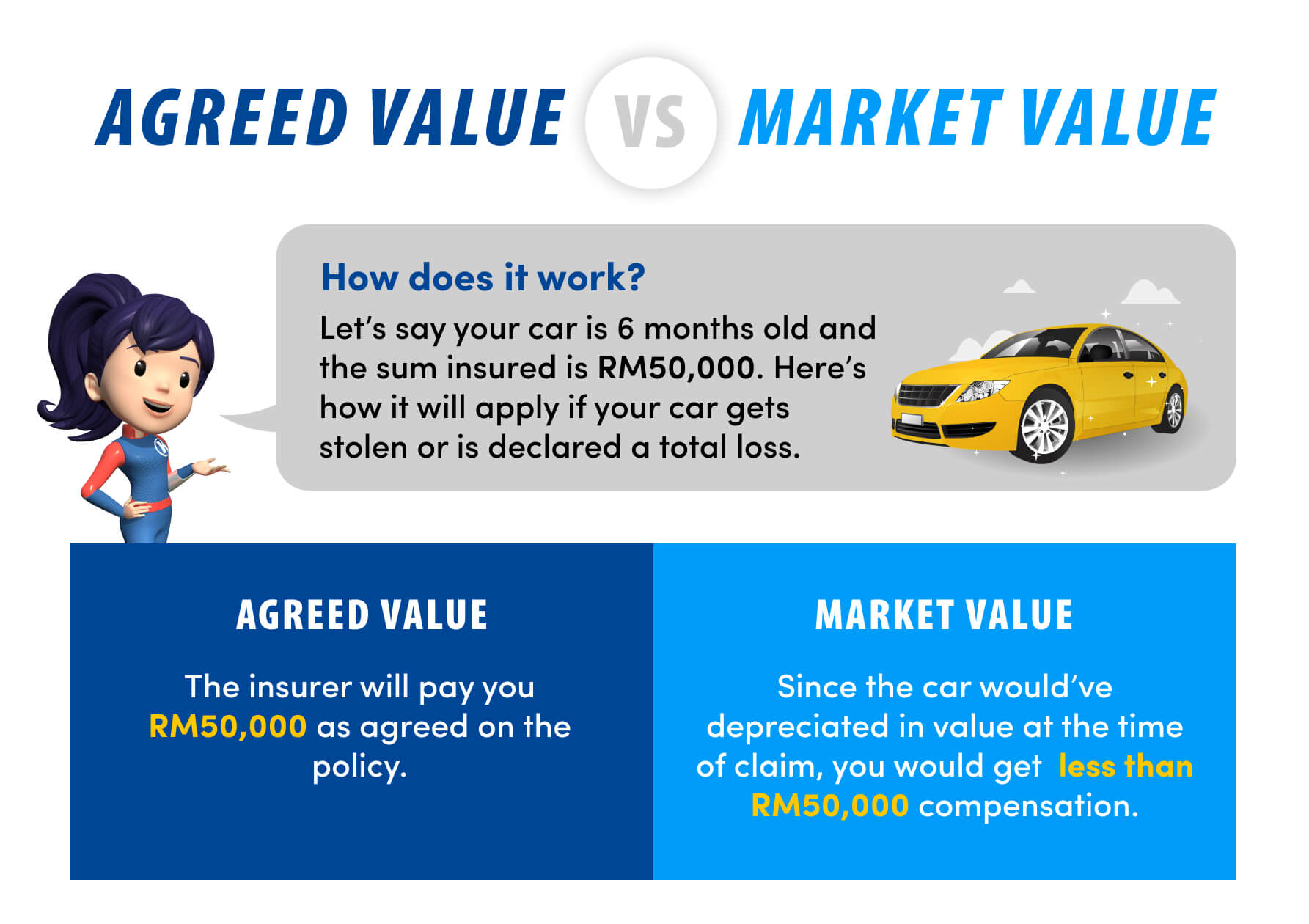A Comparison of Agreed Value and Market Value in Car Insurance

During the renewal of your car insurance, you probably encountered some confusing terms. It's likely you've seen "Agreed Value", "Market Value", and "sum insured" when deciding how much to insure your car. You've probably also seen them while researching the best car insurance plans or when reading through car insurance product brochures.
It's important to first understand the terms involved, especially if you're buying a comprehensive policy. Your choice will impact the amount of the insurance payout should you file a claim for theft or total loss.
In essence, you can also be more confident when choosing the best insurance policy for your vehicle if you understand what Sum Insured, Agreed Value and Market Value mean.
We'll explain these terms in more detail below.
Sum Insured
Simply put, the sum insured is defined as your car's insured amount that you can decide based on the current market value. The value of your car depreciates every year, and generally, the sum insured value you pick will also decrease accordingly.
By choosing the appropriate level of coverage amount, you can avoid over-insuring or under-insuring your car. You will not get full compensation for any loss or damage to your car if your vehicle is under-insured. In contrast, if you are over-insured, you would be paying a higher (and unnecessary) premium. This is because the amount of compensation you will receive is still limited to the current market value of your vehicle.
As part of the purchase process, you will typically be given two sum insured options: Market Value or Agreed Value. However, the options you have will depend on the policy and your insurer.
What is Market Value in insurance?
Not to be confused with the term "current market value", insuring your car based on Market Value means the insurer will determine your car's worth based on its current market value at any point in time. That means in the event you submit a claim for total loss or theft, the insurer will assess your claims based on the current market value of your vehicle at the time of loss.
The vehicle's Current Market value is derived from several different sources depending on the insurer. Some insurers utilise the data provided by Insurance Services Malaysia (ISM), while others may use their own proprietary data sources.
To ensure accuracy, these market values are updated frequently.
The benefit of insuring your car based on Market Value is that you are likely to pay cheaper premiums annually, although the difference can sometimes be marginal. However, if you file a total loss or theft claim, you might be getting a lesser payout than the sum insured, as your car would have depreciated when the claim is made.
Consider also that you might have to pay back the hire purchase loan using your own money, even after the entire settlement is made. This could happen, especially if you still have a large amount of outstanding balance owed to the bank.
Here's an example*
Ali's car was valued at RM50,000 when he purchased the insurance cover seven months ago. He chose to insure his car based on Market Value for the sum insured of RM50,000. Recently, his car got stolen, and he filed a claim with his insurer. If his claim is approved, the insurer will compensate based on the car's market value at the time of loss. Let's say at the time of loss, the market value for a similar model was only RM40,000. However, Ali's car still has a bank loan on it, and the remainder of the loan is RM44,000. If the total settlement is approved, Ali will still have to pay the additional RM4,000 out of his pocket.
*Examples used are for illustrative purposes only. Actual situations may vary based on an individual's circumstances.
What is Agreed Value and how is it determined?
Agreed Value means that your car is insured based on an amount that the insurer and you have agreed on. Under the Agreed Value agreement, the sum insured amount offered to you is pre-calculated based on your car's model, year, and several other factors at the point of purchase. If you file a total loss or theft claim in the future, the insurer will compensate you in full according to the sum insured you picked, regardless of the current market value.
The payout is not affected by depreciation when you have an Agreed Value policy, and you can rest easy not having to guess the payment amount.
Let's see another example*:
Jane chose to insure her car for RM50,000 based on Agreed Value. After six months, her car got damaged beyond repair, and she made a total loss claim from the insurer. The insurer will pay her RM50,000 as agreed on the policy. Let's say Jane owes the bank RM44,000 on her car loan. In this case, she can pay off her bank loan and keep the remaining RM6,000.
*Examples used are for illustrative purposes only. Actual situations may vary based on an individual's circumstances.

Is Agreed Value better than Market Value?
The short answer is that it depends on individual preference. Consider the following factors before deciding on the sum insured.
Sum Insured based on Market Value:
Pros
- The premium may be a bit cheaper, depending on your insurer.
Cons
- The payout can be less than the sum insured due to vehicle market value depreciation.
- Risk of under-insurance.
Sum Insured based on Agreed Value
Pros
- The payout is the same as the sum insured regardless of any depreciated value.
- Knowing the exact amount of compensation you will receive.
Cons
- May not be available for all plans.
- The premium may be slightly more, depending on your insurer.
With an Agreed Value policy you can get an adequate payout for your car without worrying about depreciation or under-insurance. The Market Value option, on the other hand, may save you a couple of ringgit depending on the insurer you choose.
Conclusion
Knowing how the process works better will allow you to renew your policy with greater confidence.
At Kurnia Online, all our comprehensive policies come with an Agreed Value option. All of our products feature a competitive policy premium and extended benefits. To learn more about this attractive offer, begin your quote journey.
Disclaimer: This blog post is strictly for informational purposes, and should not be taken as advice of any kind. Kurnia disclaims all responsibility for any losses resulting from reliance on the information contained in this article.